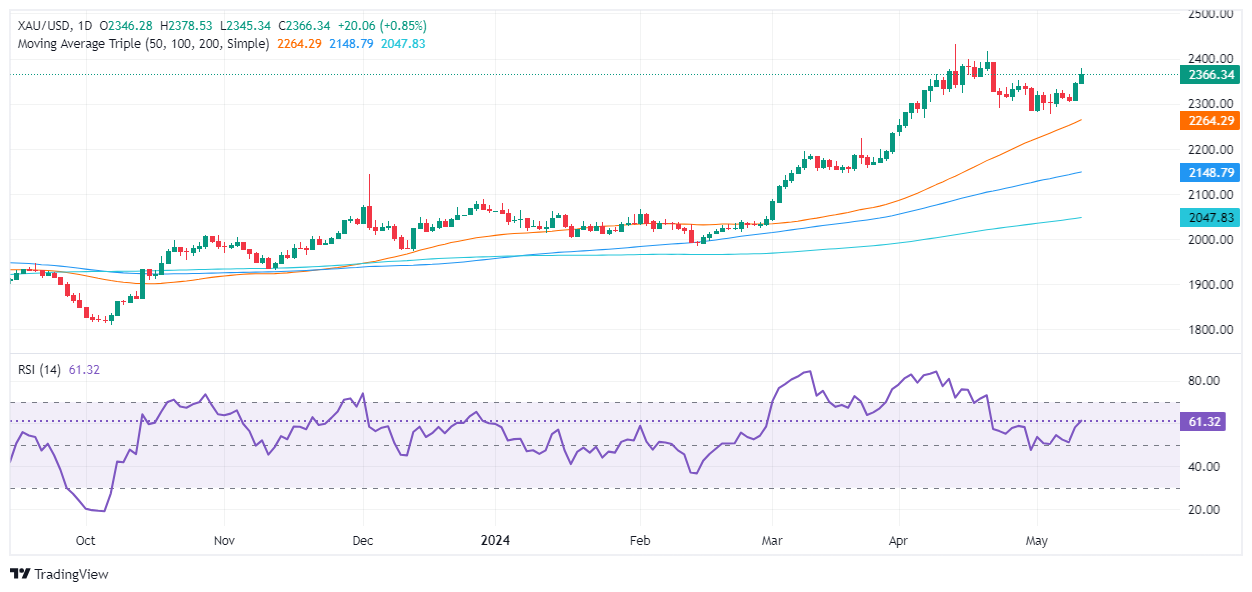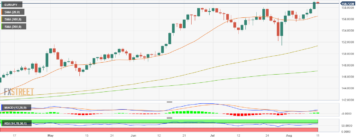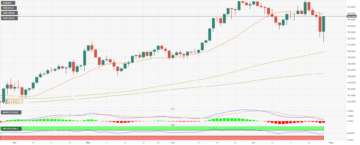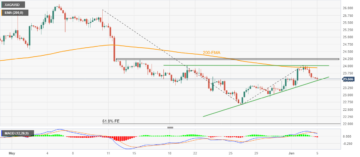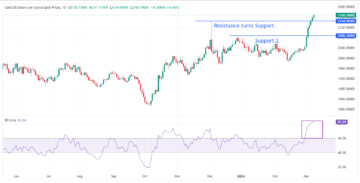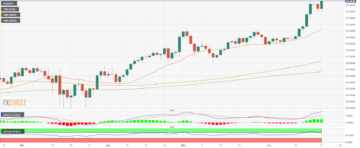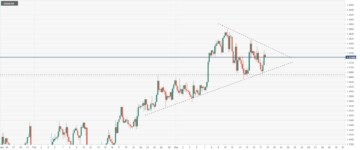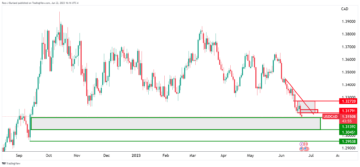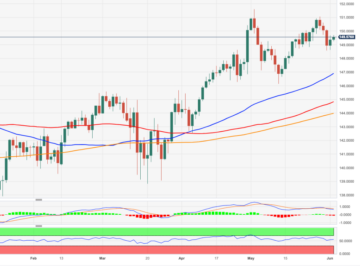- Gold rebounds from daily lows, propelled by a sharp drop in US consumer sentiment and future economic outlook.
- High US Treasury yields weren’t an excuse for Gold’s advance.
- US consumers expect inflation to remain above 3% over a one-year period.
- Fed officials are cautious about rate cuts, with mixed signals from different Fed governors.
Gold prices advanced sharply late in the North American session on Friday, up by more than 1% despite US Treasury bond yields remaining high. A University of Michigan (UoM) survey showed that Americans had become pessimistic about the economy as Consumer Sentiment plunged to its lowest level in six months.
The XAU/USD trades at $2,369 after bouncing off daily lows of $2,343. Friday’s sentiment data and the weaker labor market figures revealed since the beginning of May paint a gloomy outlook for the economy of the United States (US). Although fears of a pronounced economic slowdown remain low, market participants seeking safety drove the golden metal and the US Dollar higher.
Federal Reserve officials continued to cross newswires. Atlanta’s Fed President Raphael Bostic remained hawkish, saying the Fed is on track to just one rate cut in 2024. Later, Fed Governor Michelle Bowman said that policy needs to be kept “steady” and doesn’t see rate cuts as warranted this year. The Dallas Fed’s Lorie Logan disregarded the idea of cutting interest rates.
Minneapolis Fed Neel Kashkari has recently said he is in “wait and see mode” about future monetary policy.
Next week, the US docket will feature the release of inflation figures, retail sales, building permits and Fed speeches.
Daily digest market movers: Gold strengthens as US data increases Fed rate cut hopes
- Gold prices fell amid lower US Treasury yields and a strong US Dollar. The US 10-year Treasury note yields 4.504% and gained almost five basis points (bps) from its opening level. The US Dollar Index (DXY), which tracks the Greenback’s performance against six other currencies, rose 0.12% to 105.32.
- The University of Michigan Consumer Sentiment Index significantly declined in May, falling from 77.2 in April to 67.4 and did not meet the analysts’ expectations of 76. Joanne Hsu, the Director of the UoM Survey, highlighted that the 10-point drop is statistically significant and marks the lowest level of consumer sentiment recorded in approximately six months.
- Additionally, inflation expectations have escalated. Inflation expectations rose from 3.2% to 3.5% in May for the one-year outlook. Over a 10-year period, expectations increased slightly from 3.0% to 3.1%.
- Softer-than-expected labor market figures, as shown by last month’s US employment report and unemployment claims data, may exert pressure on the Fed. Officials recognized that the risks to achieving the Fed’s dual mandate of fostering maximum employment and price stability have become more balanced over the past year.
- After the data release, Fed rate cut probabilities increased from around 33 basis points (bps) to 34 bps points of rate cuts toward the end of 2024.
Technical analysis: Gold price resumes its uptrend, climbs above $2,350
Gold remains bullishly biased even though it retreated some 6% from its all-time high of $2,431, hit on April 12. Momentum shows that buyers are gathering steam, which is visible in the Relative Strength Index (RSI) shifting bullish since the start of May.
XAU/USD buyers cleared the April 26 high at $2,352. Despite that, Gold has consolidated at around $2,360-$2,378, with buyers unable to test the $2,400 figure. Once cleared, the next stop would be the April 19 high at $2,417, followed by the all-time high of $2,431.
Conversely, further losses are seen if Gold slides beneath the $2,300 mark. The next support would be the 50-day Simple Moving Average (SMA) at $2,249.
Gold FAQs
Gold has played a key role in human’s history as it has been widely used as a store of value and medium of exchange. Currently, apart from its shine and usage for jewelry, the precious metal is widely seen as a safe-haven asset, meaning that it is considered a good investment during turbulent times. Gold is also widely seen as a hedge against inflation and against depreciating currencies as it doesn’t rely on any specific issuer or government.
Central banks are the biggest Gold holders. In their aim to support their currencies in turbulent times, central banks tend to diversify their reserves and buy Gold to improve the perceived strength of the economy and the currency. High Gold reserves can be a source of trust for a country’s solvency. Central banks added 1,136 tonnes of Gold worth around $70 billion to their reserves in 2022, according to data from the World Gold Council. This is the highest yearly purchase since records began. Central banks from emerging economies such as China, India and Turkey are quickly increasing their Gold reserves.
Gold has an inverse correlation with the US Dollar and US Treasuries, which are both major reserve and safe-haven assets. When the Dollar depreciates, Gold tends to rise, enabling investors and central banks to diversify their assets in turbulent times. Gold is also inversely correlated with risk assets. A rally in the stock market tends to weaken Gold price, while sell-offs in riskier markets tend to favor the precious metal.
The price can move due to a wide range of factors. Geopolitical instability or fears of a deep recession can quickly make Gold price escalate due to its safe-haven status. As a yield-less asset, Gold tends to rise with lower interest rates, while higher cost of money usually weighs down on the yellow metal. Still, most moves depend on how the US Dollar (USD) behaves as the asset is priced in dollars (XAU/USD). A strong Dollar tends to keep the price of Gold controlled, whereas a weaker Dollar is likely to push Gold prices up.
- SEO Powered Content & PR Distribution. Get Amplified Today.
- PlatoData.Network Vertical Generative Ai. Empower Yourself. Access Here.
- PlatoAiStream. Web3 Intelligence. Knowledge Amplified. Access Here.
- PlatoESG. Carbon, CleanTech, Energy, Environment, Solar, Waste Management. Access Here.
- PlatoHealth. Biotech and Clinical Trials Intelligence. Access Here.
- Source: https://www.fxstreet.com/news/gold-price-soars-above-2-350-as-us-consumer-sentiment-deteriorates-202405101917
- :has
- :is
- :not
- $UP
- 1
- 12
- 19
- 2%
- 2022
- 2024
- 22
- 26
- 300
- 32
- 33
- 34
- 352
- 369
- 378
- 4
- 400
- 5
- 67
- 77
- 8
- 9
- a
- About
- above
- According
- achieving
- added
- advance
- advanced
- advances
- After
- against
- aim
- almost
- also
- Although
- American
- Americans
- Amid
- an
- analysis
- Analysts
- and
- any
- apart
- approximately
- April
- ARE
- around
- AS
- asset
- Assets
- At
- average
- balanced
- Banks
- basis
- BE
- become
- been
- began
- Beginning
- biased
- Biggest
- Billion
- bond
- Bond yields
- both
- Building
- Bullish
- buy
- Buy Gold
- buyers
- by
- CAN
- cautious
- central
- Central Banks
- checked
- China
- claims
- Commodities
- considered
- consumer
- consumer sentiment
- Consumers
- continued
- controlled
- correlated
- Correlation
- Cost
- Council
- country’s
- Cross
- currencies
- Currency
- Currently
- Cut
- cuts
- cutting
- daily
- Dallas
- data
- deep
- depend
- Despite
- DID
- different
- Digest
- Director
- diversify
- Doesn’t
- Dollar
- dollar index
- dollars
- down
- Drop
- dual
- due
- during
- Dxy
- Economic
- economies
- economy
- emerging
- employment
- enabling
- end
- escalate
- Even
- exchange
- expect
- expectations
- expected
- factors
- Falling
- FAQ
- favor
- fears
- Feature
- Fed
- Figure
- Figures
- five
- followed
- For
- fostering
- Friday
- from
- further
- future
- gained
- gathering
- geopolitical
- Gold
- gold price
- Gold Prices
- Golden
- good
- Government
- Governor
- governors
- Greenback
- had
- Have
- Hawkish
- he
- hedge
- High
- higher
- highest
- Highlighted
- history
- Hit
- holders
- How
- HTTPS
- idea
- if
- improve
- in
- increased
- Increases
- increasing
- index
- india
- inflation
- Inflation expectations
- inflation figures
- instability
- interest
- Interest Rates
- inverse
- investment
- Investors
- Issuer
- IT
- ITS
- jewelry
- joanne
- just
- just one
- Keep
- kept
- Key
- labor
- labor market
- Last
- Late
- later
- Level
- likely
- Logan
- losses
- Low
- lower
- lowest
- lowest level
- Lows
- major
- make
- mandate
- mark
- Market
- Markets
- maximum
- May..
- meaning
- medium
- medium of exchange
- Meet
- metal
- michelle
- Michigan
- mixed
- Momentum
- Monetary
- Monetary Policy
- money
- months
- more
- most
- move
- Movers
- moves
- moving
- moving average
- needs
- Neel Kashkari
- next
- North
- note
- of
- off
- officials
- on
- once
- ONE
- opening
- or
- Other
- Outlook
- over
- paint
- participants
- past
- perceived
- performance
- period
- permits
- pessimistic
- plato
- Plato Data Intelligence
- PlatoData
- played
- plunged
- points
- policy
- Precious
- president
- pressure
- price
- Prices
- probabilities
- pronounced
- propelled
- purchase
- Push
- quickly
- rally
- range
- Rate
- Rates
- recently
- recession
- recognized
- recorded
- records
- relative
- relative strength index
- Relative Strength Index (RSI)
- release
- rely
- remain
- remained
- remaining
- remains
- report
- Reserve
- reserves
- retail
- Retail Sales
- Revealed
- Rise
- Risk
- risk assets
- riskier
- risks
- Role
- ROSE
- rsi
- s
- Safety
- Said
- sales
- saying
- see
- seeking
- seen
- sentiment
- session
- sharp
- SHIFTING
- shine
- showed
- shown
- Shows
- signals
- significant
- significantly
- Simple
- since
- SIX
- Six months
- Slides
- slightly
- Slowdown
- SMA
- Solvency
- some
- Source
- specific
- speeches
- Stability
- start
- statistically
- Status
- Steam
- Still
- stock
- stock market
- Stop
- store
- store of value
- strength
- Strengthens
- strong
- such
- support
- Survey
- tend
- tends
- test
- than
- that
- The
- the Fed
- the world
- their
- this
- this year
- though?
- times
- to
- toward
- track
- tracks
- trades
- Treasuries
- treasury
- Treasury yields
- Trust
- turbulent
- Turkey
- unable
- unemployment
- university
- University of Michigan
- University of Michigan Consumer Sentiment
- uptrend
- us
- US Dollar
- US Dollar Index
- US employment report
- us treasuries
- US Treasury
- US treasury yields
- Usage
- USD
- used
- usually
- v1
- value
- visible
- weaker
- week
- weighs
- when
- whereas
- which
- while
- wide
- Wide range
- widely
- will
- with
- world
- World Gold Council
- worth
- would
- XAU/USD
- year
- yearly
- yellow
- yields
- zephyrnet

